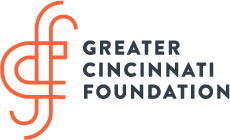Press Releases
Stay in touch with the latest happenings at Greater Cincinnati Foundation.
Greater Cincinnati Foundation Promotes Leaders to Champion...
CINCINNATI (April 26, 2024) — Greater Cincinnati Foundation (GCF) has appointed Colleen McCarthy Blair, EMPA, CAP® as vice…
Boots on the Ground Fund Awarded $834,620 to 41 Nonprofits
CINCINNATI (April 24, 2024) — Greater Cincinnati Foundation (GCF), in partnership with the City of Cincinnati and Interact for…
Greater Cincinnati Foundation Names New Leaders to Catalyze ...
CINCINNATI (March 5, 2024) — Greater Cincinnati Foundation (GCF) is poised to make an even greater impact by…
Cincinnati Black Giving Circle in Partnership with Greater...
CINCINNATI (Feb. 20, 2024) — Greater Cincinnati Foundation, in partnership with the Cincinnati Black Giving Circle, a coalition…
GCF Welcomes New Board Leadership and Two Governing Board...
CINCINNATI (Feb. 20, 2024) — In 2024, Greater Cincinnati Foundation welcomes new members and leadership to its governing…
Greater Cincinnati Foundation Names Rachel Perez as Vice...
CINCINNATI (Feb. 9, 2024) — Greater Cincinnati Foundation (GCF) has named Rachel Perez as Vice President of Finance….
Greater Cincinnati Foundation Names Sara Bolton as Chief of...
CINCINNATI (Dec. 12, 2023) — Greater Cincinnati Foundation (GCF) has named Sara Bolton as chief of staff, effective…
Greater Cincinnati Foundation Names Melissa Krabbe as Chief...
CINCINNATI (Dec. 5, 2023) — Greater Cincinnati Foundation (GCF) has named Melissa Krabbe as chief financial officer, effective…
Greater Cincinnati Foundation Names Sarah Weiss as Chief...
CINCINNATI (November 28, 2023) — Greater Cincinnati Foundation (GCF) has named Sarah Weiss as chief philanthropy officer effective…
Greater Cincinnati Foundation Names Rasheda Cromwell as Chief...
CINCINNATI (November 22, 2023) — Greater Cincinnati Foundation (GCF) has named Rasheda Cromwell to chief impact officer effective…
Boots on the Ground Fund Returns with Additional Funding
CINCINNATI (November 15, 2023) — Greater Cincinnati Foundation is pleased to announce a second round of Boots on…
Application process open for Greater Cincinnati African American...
CINCINNATI, OH — GE Aerospace announced today that the application process is open for scholarships through the Greater…
First Financial Bank Invests $500,000 in Affordable Housing Fund...
CINCINNATI, OH (August 29, 2023) — First Financial Bank (Nasdaq: FFBC) has invested $500,000 in Greater Cincinnati Foundation’s…
Greater Cincinnati Foundation Names Matthew Randazzo as Next...
Cincinnati, OH (May 11, 2023) – Setting sights on its next level of impact, Greater Cincinnati Foundation (GCF)…
GCF Welcomes Three New Governing Board Members
In 2022, we welcomed three new Governing Board members, Keith Dailey, Nirvani Head and Jen Stein, who all…
Boots on the Ground Fund Awarded $610,000 to 31 Nonprofits
CINCINNATI (March 8, 2023) — Greater Cincinnati Foundation (GCF), in partnership with the City of Cincinnati, bi3 and…
